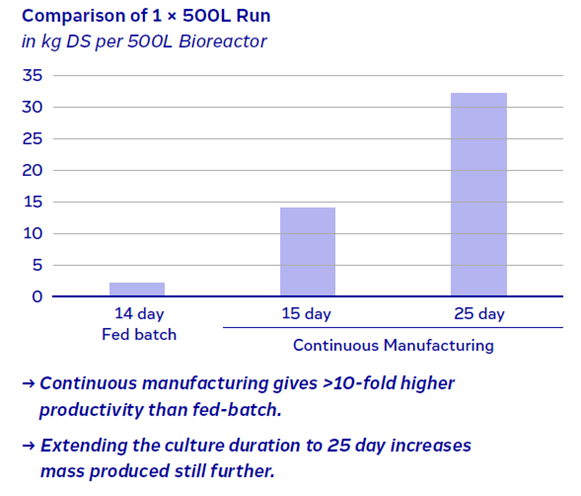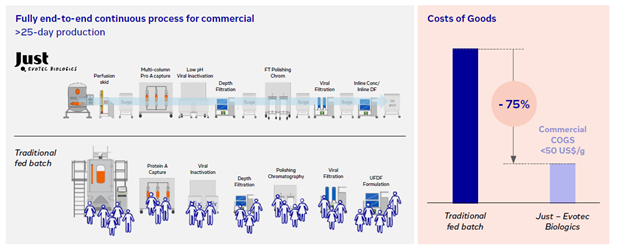Transitioning to continuous manufacturing for commercial biologics production
Transitioning to continuous manufacturing for commercial-scale biologics production represents a significant – but highly beneficial – shift in biomanufacturing strategies. This approach not only promises reduced costs, enhanced efficiency, and productivity, but also ensures consistent product quality 1.
As part of this three-part blog series, we’ve previously covered the current issues faced in biologics production, and how continuous manufacturing helps to address these. In this final blog of our series, we delve into the steps required to transition from traditional fed-batch processes to continuous manufacturing, focusing on feasibility, commercial process development, and process validation.
Assessing feasibility
The first step in transitioning to continuous manufacturing is a thorough 3-month feasibility assessment. This involves evaluating the existing fed-batch process and identifying potential challenges and opportunities for continuous operation. Just – Evotec Biologics leverages its extensive expertise in continuous manufacturing to conduct detailed feasibility studies, which include:
- Cell line assessments: We run ‘mock perfusion’ cultures in scale-down models with existing or new cell lines and assess growth, productivity, and product quality.
- Verification at 3L bioreactor scale: The most promising cultures from the cell line assessments are re-run at the 3L scale and the perfusate used to screen downstream platform conditions using high-throughput technologies.
- COGM modeling comparison: Our experts compare data from the fed-batch performance with those generated during the feasibility study. This allows for an evaluation of the COGM benefits of switching to our continuous manufacturing platform.
Intrigued about how our feasibility studies are conducted? Uncover further details here

Figure 1: Timeline of a minimally resourced, 3-month feasibility study, demonstrating margin gains, reduce risk, and validate ROI assumptions
The COGM models used in our feasibility studies are based on Net Present Costs (NPC). NPC calculations estimate cash flows by calculating operational costs and discounting over time using a cost of capital parameter 2. We use these models to compare the COGM for continuous manufacturing with existing fed-batch processes, across different post-launch demand situations. Continuous manufacturing in J.POD® facilities typically show lower operational costs, irrespective of production rates, due to our flexible facility design 2.
Commercial process development
Once feasibility is established, the next step is to develop a robust, scaled-up commercial process. This involves:
- Establishing a full 25-day end-to-end continuous manufacturing process: Establishing a continuous manufacturing process and evaluating robustness over a 25-day process, to ensure the biologic’s product quality attributes (PQAs) are maintained for the duration of the run.
- A 1000-L engineering run: At our innovative cGMP facility , a commercial-scale run is conducted to demonstrate process efficacy
- Clinical manufacturing runs: Supply subsequent clinical trials. Material is taken from these runs to generate and qualify the reference standard and perform stability studies on the drug substance (DS), ensuring regulatory compliance and future commercial success
During this development stage, we ensure the process is robust and can be seamlessly scaled up to meet commercial production demands. Our J.POD® facilities are designed to be highly adaptable, and enable a flexible process that can quickly adjust to changing market demands. Working together with our partners, we refine the continuous manufacturing process to maximize yield, productivity, and product quality.
Process validation
The final step in the transition is process validation. We perform process characterization, process validation and other Biologics License Application (BLA)-enabling studies. These include facility risk assessments, DS freeze/thaw studies, as well as shipping validation assessments.
These studies are critical for regulatory compliance and ensure consistent product quality 3. Ensuring the process meets all regulatory requirements, Just – Evotec Biologics has extensive experience in navigating regulatory landscapes, facilitating a smoother approval process.
Step into the new era of biologics manufacturing
Transitioning to continuous manufacturing is a transformative step for commercial biologics production. It offers significant benefits, including cost reduction, enhanced efficiency, and improved product quality. The additional advantage of our short feasibility studies is that they allow for the potential benefits of transitioning to be evaluated prior to committing to a full transition, substantially reducing risks. By leveraging advanced technologies and expert guidance from Just – Evotec Biologics, biopharma companies can successfully navigate this transition, stepping into the new era in biologics manufacturing.
Proven expertise in commercial manufacturing
At Just – Evotec Biologics, we wield our expertise to focus on developing and manufacturing antibody and antibody-related products, as well as biologic formats expressed in Chinese Hamster Ovary (CHO) cells. The company has demonstrated its cGMP manufacturing success over the past ten years. We provide support filing BLAs and Investigational New Drug (IND) applications. Having surpassed several cGMP compliance milestones, across the US, Canada, and the UK, Just – Evotec Biologics is positioned as a trusted global partner in the journey towards making life-saving therapies accessible worldwide.
Find out how Just – Evotec Biologics can elevate your biomanufacturing processes
References
- From Development to Delivery: How Continuous Manufacturing is Redefining the Commercial Landscape for Biologics - Science Pool. Available at: https://sciencepool.evotec.com/from-development-to-delivery-how-continuous-manufacturing-is-redefining-the-commercial-landscape-for-biologics/ Accessed 11 August, 2024
- Garcia, F.A. and Gefroh, E. Reducing biopharmaceutical manufacturing costs through continuous processing in a flexible J.POD® facility. Drug Discovery Today. (2023); 28(7):103619. https://doi.org/10.1016/j.drudis.2023.103619
- Modality Solutions, Battista R. Unlocking FDA Insights: Open Data Files for Successful BLA Submissions. Available at: https://www.modality-solutions.com/unlocking-fda-insights-open-data-files-successful-bla-submissions/ Accessed 11 August, 2024



